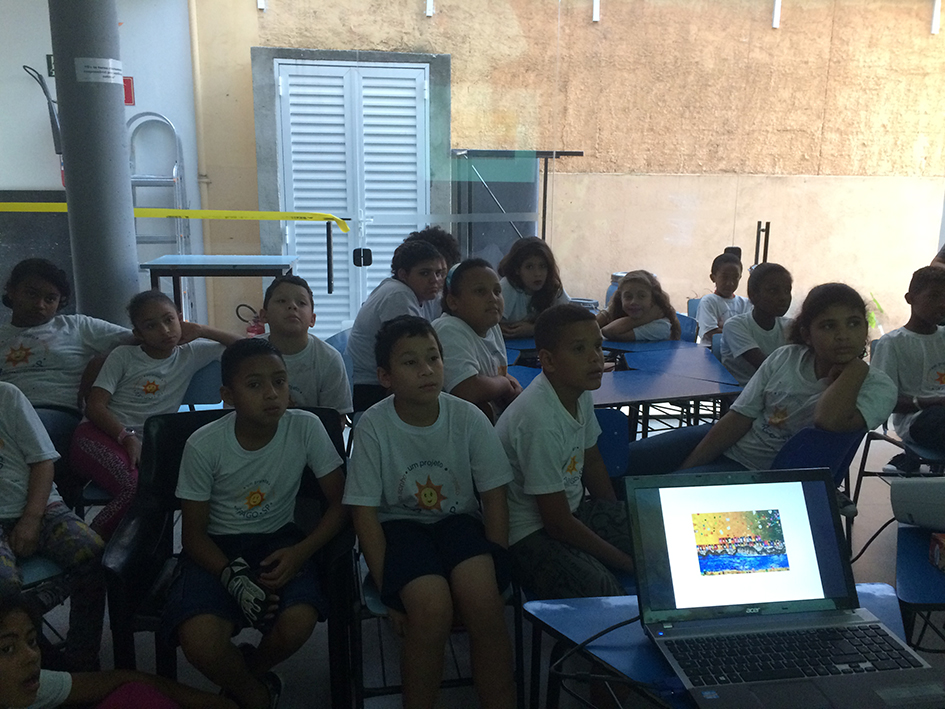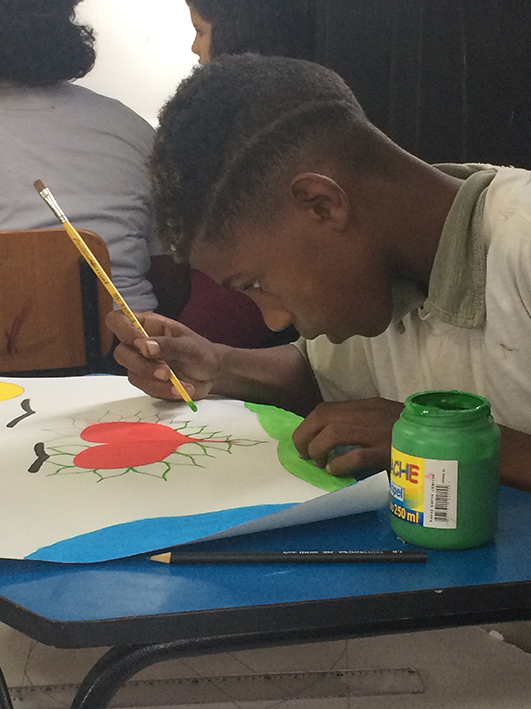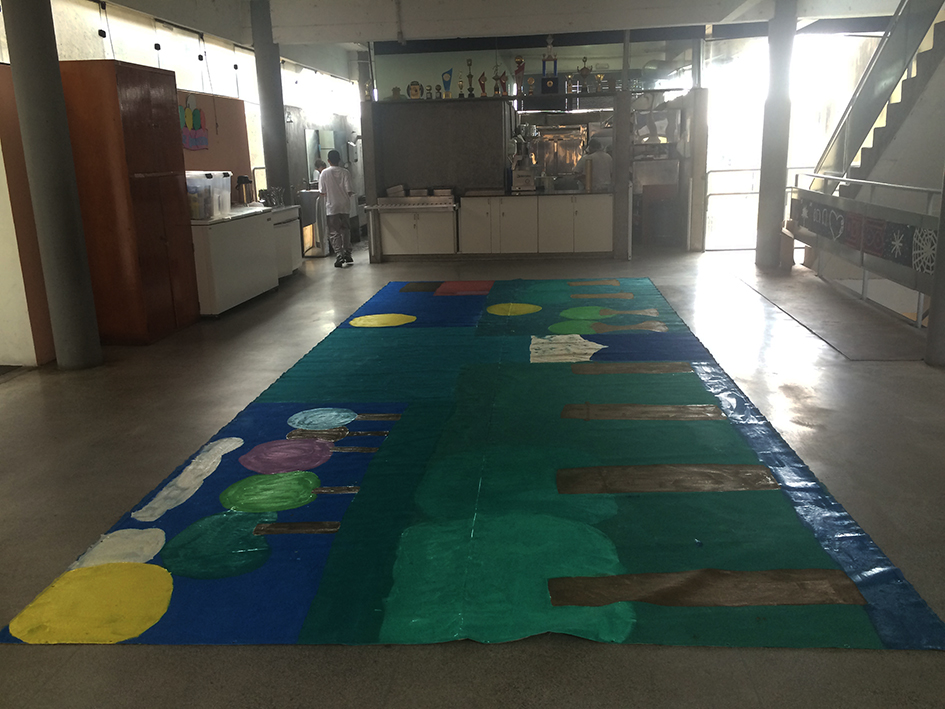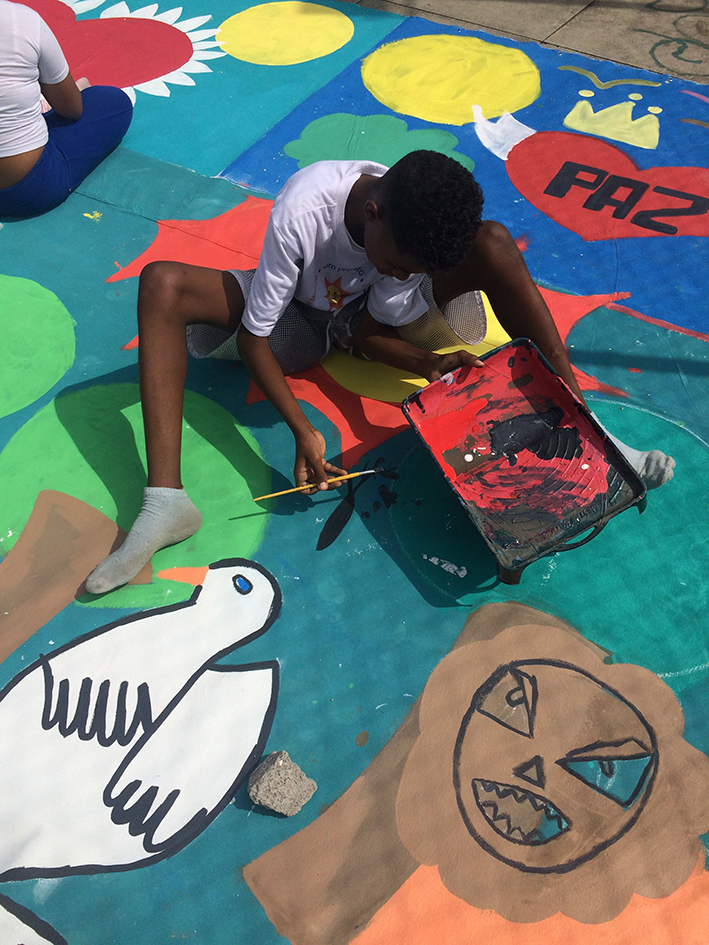Action in São Paulo 2015
Sonia Guggisberg informs:
Here you have the steps and some pictures about the Kids' Guernica – Guernica Youth project in São Paulo.
Note: Sonia Guggisberg denotes the children experience in that city at best only a virtual freedom, and in reality they encounter daily violence not only in the streets but as well at home. See Children in Sao Paulo, Brazil: virtual freedom
First step

At the beginning we showed Picasso's Guernica to the kids, done by giving them a bit of information about the painting and how this relates to war.
After that we decided to show same murals of the project which were painted by other kids in different countries.

Sonia Guggisberg with the children
Second step

As part of an educational strategy, we decided to choose some fabules which talk about peace, friendship, relationships, family...so as to give them some means to reflect about peace and to stimulate their creativity to draw and to start thinking about the panel (mural).
|
|
|
After doing this work for some weeks, we photographe all the drawings and started to think how to organize ourselves so as to be able to create something bigger, the mural.

Third step
Once everyone was ready, we started to paint by putting on the canvas layers of paint.

First, at the bottom, we painted the blue rectangulars, then the trees, animals, flowers, and the hearts...

The kids look very happy and proud about being part of a huge project.
It is easy to understand the power of inclusion that they are feeling.

After completing the grounding, they deliberate what next...
Fourth step
Up on the roof, in the sun and therefore bright light, they painted

|
|
|
|
|
|

Fifth step
...will follow in 2016 with a video showing the completion of the action
Sonia Guggisberg
A brief reflection
The photographer Sonia Guggisberg, together with director Adriana Rocha from the organization ONG which takes care of 270 children on a daily basis, has started in August 2015 an action in São Paulo.
Adriana Rocha with the children
The action was designed to link them with the world wide movement called often Guernica Kids. Naturally they begin by paying tribute to Picasso's Guernica. Likewise the action entails learning to respond in an artistic and collective way to war which hurts above all innocent people, and in particular children and youth.
Since violence has different connotations in various countries, and especially on the Latin American continent or simply in America, it is important to get to know what children who grow up in Sao Paulo of Brazil experience not only out in the streets, but likewise inside their very own homes. Often the violence they encounter, it reflects a prevailing notion of uncontrolled situations. This chaos drowned in noise made by 20 million people is due to a combination of many factors. It includes corruption at all levels, to be attributed next to an inefficient police force and politicians blocking each other, to the very absence of a strong civic society. Everywhere there can be felt a lack of a culture which could sustain democratic practices and non violent interactions. Peace is missing in all parts of society, and not only in the poorer areas. A life in dignity is made impossible for the many who live permanently at the extreme edge of poverty or fully in it, but also all others giving in too readily to eccentric behaviour.
Just touching a bit upon this complex, there needs to be perceived an urban society in Sao Paulo which is constantly on the move. To survive requires a different kind of conviction, something not all have as the city is over stretched in the use of natural resources. In particular, water is a problem.
Sonia Goggisberg herself has been shot two and a half years ago and nearly died becaue of this incidence. She was driving her car with the windows rolled up when two man stepped up and pulle the trigger to send bullets through the window. One bullet went through her nose and came out just underneath her eyes. She bleed strongly. All she could think of was to survive. She made just by driving herself to a close-by hospital. On the way, she managed to call her oldest son in order to alarm the emergency at the hospital. Luckily it was only half a mile down the road.
Sonia describes this situation in her terms as a photographer who tends towards perceiving life on the move. Hence she works with video or moving pictures in contrast to stills when constructing huge installations. Her works include showing such aspects of life as loss of memory or what is too often forgotten even though it was just recently a valued part of everyday life.
She talks about many issues and problems faced by the society of Brazil about to host the Olympic Games in 2016 and where the world football games were just staged recently with Germany winning the world title. She would talk of a wide range starting from the complications of getting water in a city where the reservoirs are near to drying up completely to living in a virtual world and therefore at risk to be flooded by all kinds of information. Alone this contrast between dryness and over abundance of information, but often the wrong kind, prompts thoughts in her mind as to what kind of orientation children and youth need, if they are to grow up in such a city.
All these thoughts can be linked to a vision often dismissed as being politically naive since it is of a deep humanist orientation. For many who have not as of yet entered such an experience to be made once one has entered such a collaborative learning process of painting a mural of peace together, it seems to them as if this type of action has little or no impact upon the real events in society. But life of human beings is shaped by what constitutes a real experience of the imagination to allow reaching out to others. For the imagination makes possible both empathy for and dialogue with the other. The Kids' Guernica - Guernica Youth experience is not a tool. It is about finding the human voice amidst all the sounds and noises to be heard in a city.
Once students of the University Saint Denis with Monique Kissel as their professor for art examined the human cry in Picasso's Guernica. They concluded that we as human beings witness only rarely the human outcry for it is expressed, if at all, solely within such an intimate space, that there are no other witnesses around.
Wondering whether or not this human cry can be heard, nevertheless each mural represents a linkage children can only create between their wishes and the real needs they sense.
These children and youth resort to their imagination, in order to overcome the obstacles and dangers existing in such volatile situations being constantly re-created in cities basically out of control in human terms. At best, it is a kind of chaos which makes daily human encounters nearly impossible.
If anything, these action are about finding the human voice. By painting together the mural, they learn to listen to their own voices. They do so by discovery and experience that there are others who have a similar desire to do something great and outstanding, equally human. And it is made possible by being together within this huge space which the canvas having the same size as Picasso's Guernica (7,8 3,5) offers.
The impact cannot be greater than them finding the courage to speak out, and this in such a creative way that they discover and develop further a new symbolic language. It may unconsciously reflect the flower which was once squashed by a tank having rolled over it. If that is a kind of resurrection of hope, then let it be a first step to a blue moon because children see things differently. They express themselves as a result not only in their own language, but what they can create together by developing a common trust into what reflects their wish for a reality in which they can do things together. By making a 'visual literacy' become their common understanding, they indicate directly what is needed to preserve peace and freedom in this world.
The experience they make while going through this process of painting together brings new references into their existence. They can resort to them whenever is needed to have a voice and arguments as to what is possible once the sharing of a common is heeded and others are listened.
In reality, the empathy felt to come from of the others makes the mural into a magic carpet. They can fly off once they step onto it with their imagination.
Hatto Fischer
Athens 11.12.2015
« Raynald Driez | Children in São Paulo »






